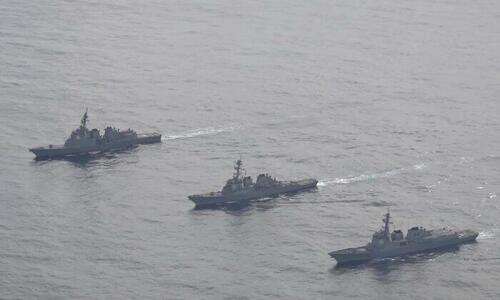US, Japan Unveil ‘Extended’ Deterrence Guidelines, Citing Rising Nuclear Threats
Authored by Tom Ozimek via The Epoch Times,
The United States and Japan have unveiled new guidelines for “extended” deterrence, citing an “increasingly severe strategic and nuclear threat environment” that reflects heightened tensions in the Indo-Pacific, where China, Russia, and North Korea have taken steps to modernize their arsenals and project power.
The guidelines, unveiled on Dec. 27 through coordinated statements from the U.S. State Department and Japan’s Ministry of Foreign Affairs, underscore the two nations’ commitment to reinforcing their alliance to maintain regional stability and deter conflict.
“The Alliance will continue to explore how best to ensure extended deterrence is strong and credible,” read the identical statements from the two countries.
The guidelines are the culmination of long-running discussions under the Extended Deterrence Dialogue, a bilateral framework established in 2010 to address challenges to the U.S.–Japan alliance posed by evolving security threats.
Details of the new guidelines have not been disclosed.
Both the United States and Japan said that the document emphasizes enhancing strategic messaging to ensure adversaries clearly understand the alliance’s resolve and capabilities. The measures also include bolstering U.S. extended deterrence with Japan’s defense advancements, such as enhanced missile defense systems and readiness to respond to contingencies.
The joint announcement coincided with Japan’s Cabinet approval of a record $55 billion defense budget for 2025, marking the third year of a sweeping five-year military buildup under Japan’s national security strategy adopted in 2022. The broader national budget bill, totaling over $730 billion, is set for parliamentary approval by March.
Part of Japan’s plan involves bolstering its missile defenses. To this end, Japan has allocated another $3.37 billion for interceptors and a mobile reconnaissance radar on Okinawa, a strategic location hosting more than half of the 50,000 U.S. troops stationed in Japan.
Japan is also preparing to deploy U.S.-made Tomahawk cruise missiles by late 2025, a pivotal step in its bid to acquire strike-back capability. The defense budget allocates $6 billion for a “standoff” defense system that includes long-range missiles, satellite constellations, and other advanced arsenals. Among these, $11.4 million is earmarked for outfitting Aegis-class destroyers to launch Tomahawks.
The five-year strategy also aims to double Japan’s annual military spending to around $63 billion, positioning Japan as the world’s third-largest military spender, behind the United States and China.
The new deterrence guidelines and Japan’s record defense budget signal a united front aimed at countering growing regional threats, reflecting concerns over China’s growing military assertiveness, North Korea’s persistent missile tests, and Russia’s activities in the Indo-Pacific.
Japan’s newly elected Prime Minister Shigeru Ishiba has been outspoken about the inadequacy of traditional deterrence frameworks. In a recent interview with the Hudson Institute, Ishiba warned that developments in nuclear weaponry and delivery systems by adversaries could undermine U.S. extended deterrence.
Ishiba has proposed the creation of an “Asian version of NATO” that would ensure deterrence against the “nuclear alliance of China, Russia, and North Korea,” while calling for nuclear-sharing agreements and the potential deployment of U.S. nuclear weapons on Japanese soil.
Tyler Durden
Sat, 12/28/2024 – 22:10


